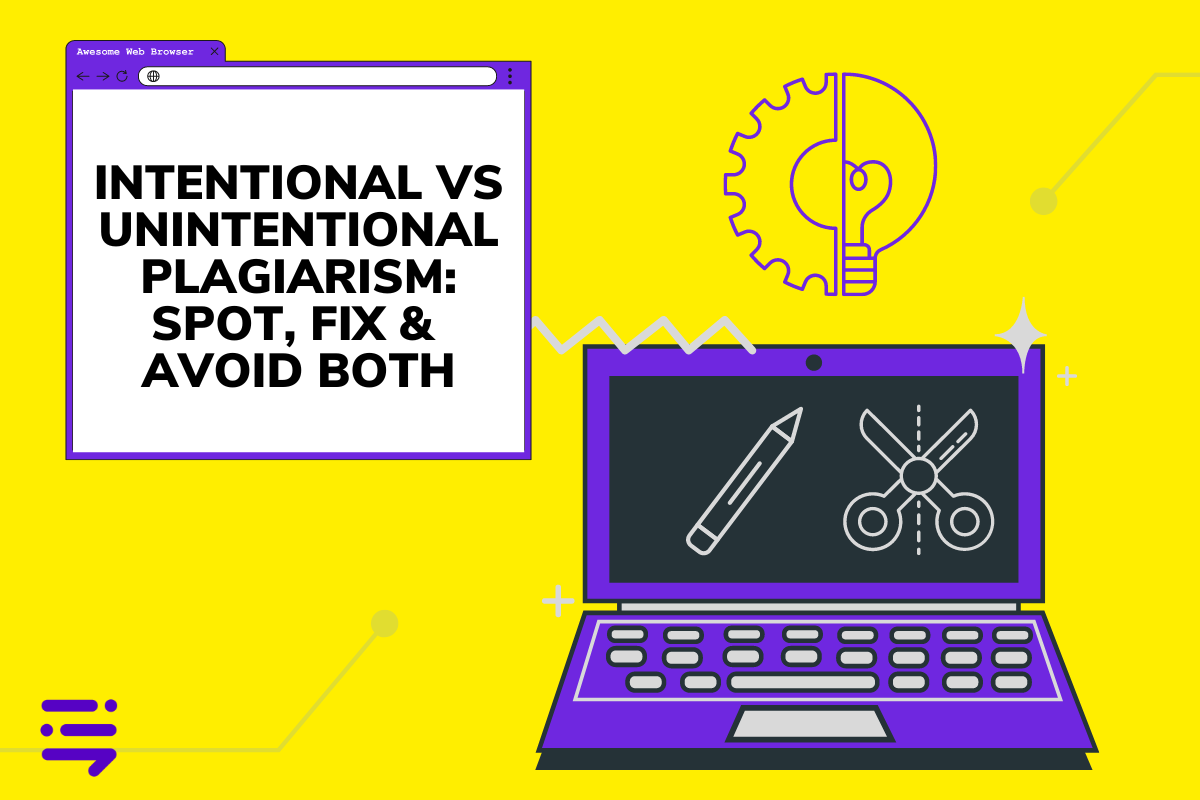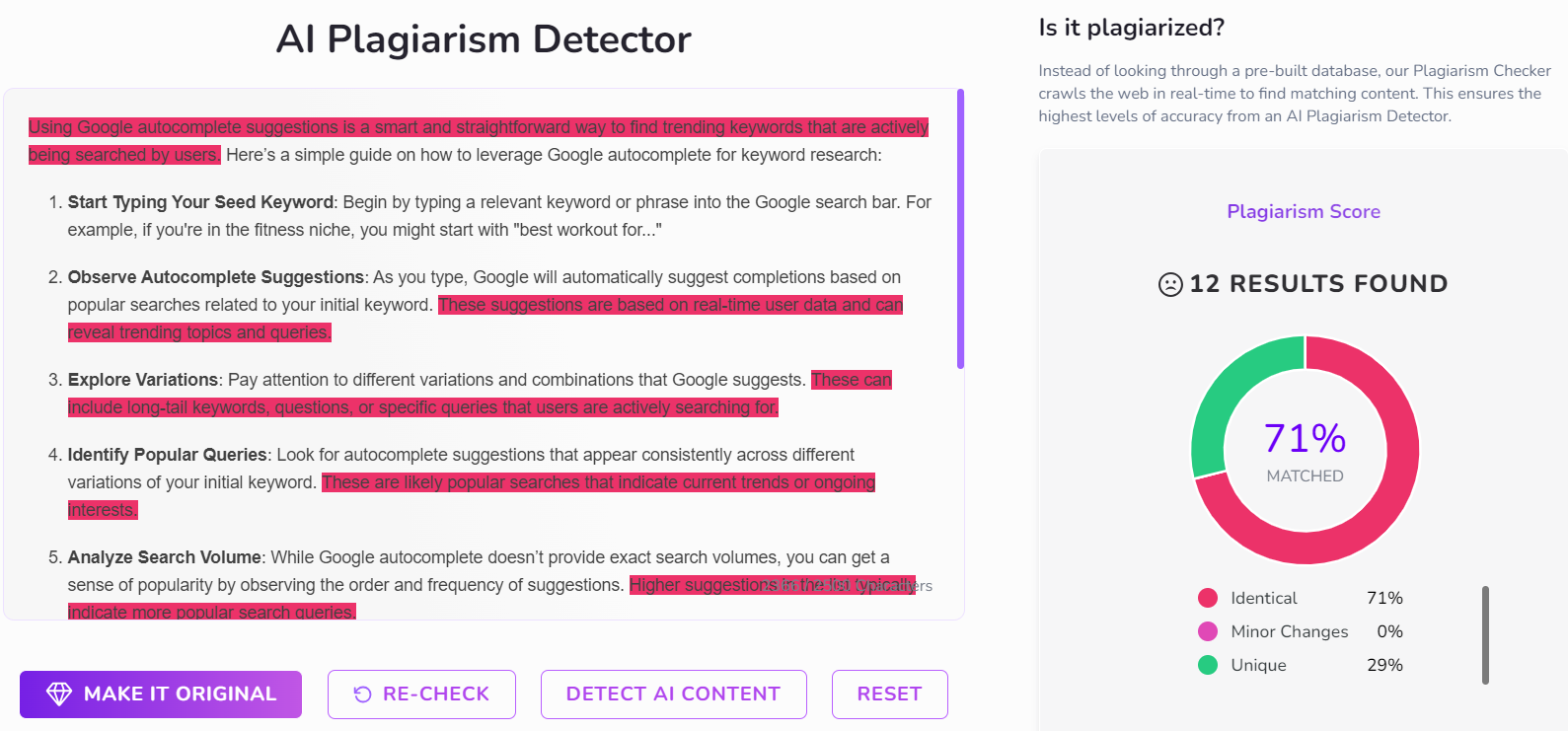Discover top guides, trends, tips and expertise from AIO Writers
Intentional vs Unintentional Plagiarism: Spot, Fix & Avoid Both
Justin McGill
Friday, 21st Jun 2024
Picture this: you’re hard at work on a paper, feeling the pressure of a deadline, but also proud of the ideas you’re putting on the page. You turn it in feeling confident, only to have your professor pull you aside with concerns about plagiarism.
Did you just copy someone’s words unintentionally?
Being able to spot intentional vs unintentional plagiarism could mean the difference between a teaching moment and a serious academic offense.
Many students find themselves tripped up not by a desire to cheat, but by the nuances of properly citing outside sources.
The lines between acceptable research practices and plagiarism can be blurry. That’s why understanding the difference between intentional vs unintentional plagiarism is so crucial.
Whether you’re a seasoned writer or just starting college, knowing the difference can save you a lot of trouble. Plus, getting it right lets your original thinking shine through, which is what good writing is all about.
Table Of Contents:
- What is Plagiarism?
- Why Both Types of Plagiarism Are a Big Deal
- Navigating the Gray Areas of Accidental Plagiarism
- Preventing Plagiarism: Build Good Habits
- FAQs: Intentional vs Unintentional Plagiarism
- Conclusion
What is Plagiarism?
In simple terms, plagiarism is presenting someone else’s work as if it were your own.
This includes their words, ideas, data, and even music.
It’s like taking credit for someone else’s amazing cake recipe.
In an academic setting, this applies not just to copying and pasting entire chunks of text, but also to less obvious offenses.
There are two common types of plagiarism: intentional and unintentional.
Intentional Plagiarism: A Deliberate Act
Intentional plagiarism is when you know you’re taking someone else’s work and trying to pass it off as your own. It’s a conscious choice, driven by various factors – maybe feeling overwhelmed, time crunches, or even a misguided attempt to get a better grade.
Examples of this include:
- Submitting a paper you bought online or from an essay mill.
- Turning in an essay a friend or family member wrote.
- Copying and pasting chunks of text from sources without citations.
The consequences for this can be significant, ranging from a failing grade to expulsion from school, and can have lasting effects on your academic and professional record.
Unintentional Plagiarism: Honest Mistakes, Big Impact
Now, this is where it gets a bit tricky.
Unintentional plagiarism, or accidental plagiarism, occurs when someone plagiarizes without realizing it or intending to do so. It often happens due to a misunderstanding of citation rules, poor paraphrasing skills, or simply forgetting to credit a source.
Here are a few situations where you might accidentally plagiarize:
- Paraphrasing by only changing a few words, but keeping the same structure as the original.
- Forgetting to include quotation marks when directly quoting a source, even if you cite it.
- Not citing ideas or concepts that aren’t considered “common knowledge.”
- Citing a source but making mistakes in the formatting.
You’ll find more examples of plagiarism, intentional and unintentional, but it all boils down to representing yourself and your work accurately.
Just like you wouldn’t submit a group project without listing all the contributors, you need to be meticulous about crediting your sources in every piece of writing.
Why Both Types of Plagiarism Are a Big Deal
Whether it’s intentional vs unintentional plagiarism, both damage academic integrity.
At their core, both undermine the principles of originality and honest scholarship.
Intentional plagiarism is a deliberate act of deception, but even unintentional plagiarism can result in serious academic penalties.
While the intent might be different, the consequences of both types of plagiarism remain similar — damaged reputations and a breakdown in trust between students and educators and authors and readers.
Navigating the Gray Areas of Accidental Plagiarism
Knowing the ins and outs of plagiarism isn’t as simple as just ‘don’t copy.’
Some areas get a bit murky. It’s where understanding the nuances of proper research and citation is crucial. This is especially relevant when talking about unintentional plagiarism.
The Temptation of Online Resources
The internet, with its vast amount of readily accessible information, can sometimes make accidental plagiarism easy.
And now with the arrival of AI chatbots like ChatGPT, finding answers is easier than ever. But this convenience also makes it simple to accidentally copy and paste information without proper attribution, often without even realizing you’re doing it.
The Pressure Cooker of Academic Life
Deadlines, workload, and complex assignment requirements can increase instances of plagiarism. Students may resort to copying because they feel overwhelmed by these demands.
Add to that the challenges international students face, often navigating cultural differences and language barriers.
You can see how unintentional plagiarism might easily occur, particularly when research and writing conventions differ across cultures and education systems.
Preventing Plagiarism: Build Good Habits
While understanding intentional vs unintentional plagiarism can seem overwhelming, the good news is that both are largely preventable. The key to avoiding plagiarism is to make good habits a part of your research and writing routine.
By staying organized and diligent in your approach to information, you can steer clear of the common pitfalls of accidental plagiarism.
Start Strong with Note-Taking
Clear, organized notes are your best friend. Whether using index cards, digital note-taking apps, or good old-fashioned notebooks, use a system that works for you and makes it easy to distinguish your ideas from those you’re gathering from sources.
Use quotation marks diligently to highlight direct quotes, making it less likely you’ll later forget to attribute them properly.
Master the Art of Paraphrasing
Paraphrasing is more than just changing a few words in a sentence; it’s about deeply understanding a source and then explaining those concepts in your own words — as if you were explaining it to a friend who hasn’t read the material.
This can be tricky but it’s a skill that gets easier with practice.
Get more tips on effective paraphrasing that bypasses plagiarism checks.
Remember, a good paraphrase demonstrates your understanding of a source. And it can help make complex information more relatable.
Give Citing Sources Your Full Attention
I know, different citation styles (APA, MLA, Chicago) can feel like learning a new language, but trust me, mastering the nuances is crucial.
These systems may seem nitpicky at first. But remember, citation styles are designed to make it crystal clear which ideas are yours and which come from your sources.
Consistently using the correct style throughout your paper makes it much less likely you’ll make an unintentional mistake that could be flagged for intentional plagiarism.
Plus, a properly formatted bibliography adds to your paper’s credibility, demonstrating thoroughness and a strong understanding of academic standards.
Use Online Tools Wisely
The same technology that can make plagiarism easier to commit can also be used to avoid it.
Plagiarism detection tools like BrandWell can help identify passages in your writing that might need better paraphrasing or citation.
In the example below, BrandWell found instances of plagiarism in 71% of the text written by ChatGPT!

You might even uncover accidental omissions, such as missing quotation marks around direct quotes, ensuring that you’ve represented your sources with complete transparency.
Whether it’s intentional or unintentional plagiarism, BrandWell can help safeguard your reputation before you submit or publish your work
FAQs: Intentional vs Unintentional Plagiarism
What is the difference between intentional and unintentional plagiarism?
Intentional plagiarism involves knowingly passing off someone else’s work as your own. This can include buying papers online, submitting someone else’s work, or directly copying from a source. Unintentional plagiarism is not on purpose, usually a result of improper citations or paraphrasing too closely to the original text.
What is an example of unintentional plagiarism?
Say you’ve done some research on a topic, and you’re writing your paper. You’ve changed a few words from the original source, thinking you’ve made it your own. You might even cite the source, acknowledging where you got the idea. But, because the sentence structure mirrors the original so closely, it could be flagged as plagiarism.
What are the two main types of plagiarism?
Intentional and unintentional plagiarism are the two main types of plagiarism.
What is the one thing intentional plagiarism and unintentional plagiarism have in common?
Whether done intentionally or by mistake, both damage academic integrity, often carrying similar penalties.
Conclusion
Knowing the distinction between intentional and unintentional plagiarism is crucial for maintaining academic and professional integrity.
While intentional plagiarism involves a deliberate attempt to deceive by claiming someone else’s work as your own, unintentional plagiarism often stems from a lack of awareness, carelessness, or poor citation practices.
Both forms can have serious consequences, underscoring the importance of diligence in research, writing, and proper attribution. By educating ourselves on these differences and adhering to ethical guidelines, we can uphold the standards of honesty and originality in our work.

UNLOCK YOUR POTENTIAL
Long Headline that highlights Value Proposition of Lead Magnet
Grab a front row seat to our video masterclasses, interviews, case studies, tutorials, and guides.



